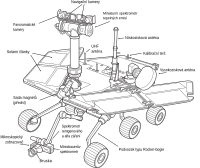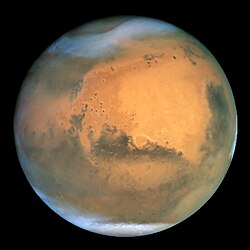Pancam

PanCam je označení dvou elektronických stereofotoaparátů na vozítkách Mars Exploration Rover Spirit a Opportunity.[2] Fotoaparát s vysokým rozlišením je schopen zachytit obraz v různých vlnových délkách světla a spojit jej ve dvou navigačních kamerách zvaných NavCam.[2] Je určen pro stereoskopické snímkování terénu, obě kamery jsou vybaveny kotoučky s filtry pro odhad mineralogického složení hornin a půdy v okolí. Fotografické kamery vyrábí společnost Jet Propulsion Laboratory, Passadena (USA).
Princip
Podle Cornellovy univerzity mohou spolupracovat se zařízením Mini-TES a analyzovat okolí.[2] Fotoaparáty využívají ke své kalibraci zařízení MarsDial (kalibrační terč).[3] To v rozích obsahuje několik barevných destiček pro barevnou kalibraci a ve vnitřním kruhu je několik šedých ploch v různých stupních šedé barvy a zrcátko odrážející oblohu.[4]
Kamery jsou určeny pro stereoskopické snímkování terénu, obě jsou vybaveny osmi kotoučky s různě barevnými filtry, které umožňují zobrazovat snímky v různých barvách viditelného světla i ve světle infračerveném. Tím, že fotoaparáty vnímají Mars v těchto různých barvách, mohou odborníci lépe zkoumat mineralogické složení hornin a půdy v okolí. Operátoři Pancamu mohou také snímky pořízené touto kamerou převádět do reálných barev, jak by je vnímaly na Marsu lidské oči. Fotografie jsou generovány z matematických kombinací šesti kalibrovaných expozic (obrázků) pořízených pomocí různých filtrů od 430 nanometrů do 750 nanometrů vlnové délky (viditelné světlo).
Kamera disponuje objektivem s ohniskovou délkou 38 mm, světelností f/20, zorné pole 16.8x16.8°, úhlové rozlišení 0.28 mrad/pixel a dosahuje expozičních časů 0 až 30 sekund. Má relativně vysoké rozlišení 1024x1024 pixelů s detekčním prvkem CCD a spektrální obor citlivosti 400 až 1100 nm.[5]
Ve srovnání s Pancamem na Mars Exploration Rover (MER) má MastCam-34 na vozítku Curiosity rover 1,25 × vyšší prostorové rozlišení a MastCam-100 na témže vozítku má 3,67 × vyšší prostorové rozlišení.[6]
Galerie
Odkazy
Reference
- ↑ NASA - PIA07942
- ↑ a b c Athena - PanCam
- ↑ About the Pancam and calibration target
- ↑ Cornell University - Sundial
- ↑ http://www.kosmo.cz/modules.php?op=modload&name=kosmo&file=index&fil=/p/index.php?cid=37
- ↑ Mars Science Laboratory (MSL): Mast Camera (Mastcam): Instrument Description [online]. Malin Space Science Systems [cit. 2009-04-19]. Dostupné online. (anglicky)
Související články
- Curiosity rover
- Mars (planeta)
Externí odkazy
 Obrázky, zvuky či videa k tématu Pancam ve Wikimedia Commons
Obrázky, zvuky či videa k tématu Pancam ve Wikimedia Commons - PanCam
- Oficiální stránky projektu
- česká stránka o průběhu mise vozítka Spirit
- česká stránka o průběhu mise vozítka Opportunity
Média použitá na této stránce
Original Caption Released with Image:
- These two images from 10 days apart show that dust was removed from the panoramic camera's calibration target on NASA's Mars Exploration Rover Spirit. Spirit's panoramic camera took the picture on the left on the rover's 416th martian day, or sol, (March 5, 2005) and took the picture on the right on sol 426 (March 15, 2005). During the time in-between, other evidence of dust-lifting winds were a jump in power output by Spirit's solar arrays on sol 420 from removal of some accumulated dust, and sighting of two dust devils in sol 421 images from Spirit. The size of the base plate on the calibration target shown in both of these images is 8 centimeters (3.15 inches) on each side.
- These are the panoramic camera team's best current attempt at generating "true color" views of what these scenes would look like if viewed by a human on Mars. They were generated from mathematical combinations of six calibrated, left-eye Pancam images for each sequence, using filters ranging from 430-nanometer to 750-nanometer wavelengths.
This image taken at JPL shows the panoramic camera used onboard both Mars Exploration Rovers. The panel to the lower right highlights the multicolored filter wheel that allows the camera to see a rainbow of colors, in addition to infrared bands of light. By seeing Mars in all its colors, scientists can gain insight into the different minerals that constitute its rocks and soil.
NASA's Hubble Space Telescope took the picture of Mars on June 26, 2001, when Mars was approximately 68 million kilometers (43 million miles) from Earth — the closest Mars has ever been to Earth since 1988. Hubble can see details as small as 16 kilometers (10 miles) across. The colors have been carefully balanced to give a realistic view of Mars' hues as they might appear through a telescope. Especially striking is the large amount of seasonal dust storm activity seen in this image. One large storm system is churning high above the northern polar cap (top of image), and a smaller dust storm cloud can be seen nearby. Another large dust storm is spilling out of the giant Hellas impact basin in the Southern Hemisphere (lower right).
Schematic drawing Mars Exploration Rover Image by National Aeonautics and Space Asministration Source: http://marsrovers.jpl.nasa.gov/newsroom/merlandings.pdf
From website: "This is the first color image of Mars taken by the panoramic camera on the Mars Exploration Rover Spirit. It was the highest resolution image ever taken on the surface of another planet." This version has been cropped.
Colour Panorama of 'Santa Maria' Crater on Mars, taken by the Opportunity rover.
Original caption from NASA: "NASA's Mars Exploration Rover Opportunity is spending the seventh anniversary of its landing on Mars investigating a crater called "Santa Maria," which has a diameter about the length of a football field.
This scene looks eastward across the crater. Portions of the rim of a much larger crater, Endurance, appear on the horizon. The panorama spans 125 compass degrees, from north-northwest on the left to south-southwest on the right. It has been assembled from multiple frames taken by the panoramic camera (Pancam) on Opportunity during the 2,453rd and 2,454th Martian days, or sols, of the rover's work on Mars (Dec. 18 and 19, 2010)."
Autor: Rtphokie, Licence: CC BY-SA 3.0
PanCam Mast Assembly (PMA) aboard Mars Exploration Rovers, from full scale reproduction on display at the Virginia Air and Space Center











